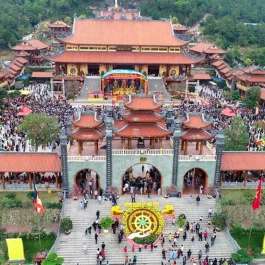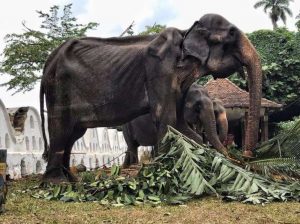Praises to the Twenty-One Taras—aspects of the Swift Savioress, the feminine manifestations of enlightenment, who protect living beings from epidemics, wars, famines, bad dreams, insanity, and other malefic forces of the world—have been chanted by Tibetan Buddhists for centuries. Scroll paintings (T. thangkas) and statues support their visualization, although it is difficult for a flat representation or a single statue to convey fully the sense that Tara’s benefit radiates from a celestial pure realm. In meditation, this is discovered in the practitioner’s own mind.
At Khadro Ling, a Vajrayana Buddhist center established by the late meditation master Chagdud Tulku Rinpoche (1930–2002) in southern Brazil, a Tara Garden was recently constructed with five lotus pedestals supporting a central deity (one meter high), surrounded by four larger lotuses, each supporting a grouping of five Taras (50 centimeters high). The creation of the garden evolved from the residents’ daily practice of Red Tara meditation and the recitation of Praises to the Twenty-One Taras. It was inspired as well by a wish to offer the many visitors of Khadro Ling a focus for their prayers and aspirations.
The statues were carved in Orissa by artists who have maintained the ancient Indian tradition of carving temple goddesses from sandstone. Two 9th-century temples, originally with 64 standing yoginis (one temple has now lost two of its statues), can still be found in Orissa, near Bhubaneshwar and Titilagarh. Although the Tara statues at Khadro Ling are seated, their serene faces, curvaceous bodies, and exquisitely detailed ornaments and attire are in the classical style. They are carved from delicate, pinkish-beige sandstone transported 1,500 kilometers from Jaipur. The stone found in Orissa itself is mottled with dark maroon, giving the noble ladies blotchy complexions and unpredictable daubs on their clothes, so the extra cost of the Jaipur stone was considered well worth it.
Each Tara holds her right hand down at the knee, palm facing out, expressing supreme generosity. In her left hand, each holds the stem of a lotus that opens next to her ear. Presently they are missing the symbolic implements that should rest on top of these lotuses because of concern that they would be broken in transport from India to Brazil. An accurate set of implements has been carved by a Bhutanese artist who is in residence at Khadro Ling, and these will soon be installed on the lotus tops. A second set will be sent to Orissa to be copied in stone, shipped to Brazil, and installed later.
The central Tara will hold a bow and arrow made of lotus flowers, expressing skillful means and wisdom. The twenty retinue Taras are grouped in four families who carry out four modes of activity. To the east, on the lotus in front of the central Tara, are the five Taras of the Vajra family, whose activities are to subdue peacefully. The central Vajra-family Tara holds a mirror that symbolizes the clarity and mirror-like wisdom that arises when anger is pacified. To the south, on the right of the central Tara, are the five Taras of the Ratna (Jewel) family, who increase wealth, qualities, and longevity. The central Ratna-family Tara holds a wealth bumpa (vase) and expresses the wisdom of equanimity when all the calibrations of ego-centered pride are overcome.
To the west, behind the central Tara, are the five Taras of the Lotus family, whose activities are to magnetize the minds of beings and all that is necessary on the path to enlightened awareness. The central Lotus-family Tara holds an upright conch shell signifying the purification of speech and reputation, and the wisdom of discerning the true nature of phenomena. To the north, on the left of the central Tara, are the five Taras of the Karma family, whose activities are energetic, wrathful activities to protect from harm. The central Karma-family Tara holds a Dharma wheel, signifying that the Buddha’s Dharma teachings are the source of an all-accomplishing wisdom that overcomes all jealousy.
The enclosure for this sacred arrangement (mandala) evolved through a sequence of architectural renditions. The 9th-century yogini temples near Orissa are circular, with their 64 statues on the inner wall and shallow, ornamental arches separating them. Khadro Ling’s first drawings by volunteer architects were based on these temples, but the site was too small and the open center of the circle would have provided no shade or rain protection for visitors. A more traditional Tibetan temple—texts say that Tara’s celestial palace is shaped like a three-quarter moon—was designed, but plans seemed at odds with the Indian-style statues.
Finally, a six-sided, double-roofed pagoda structure provided a hybrid design that does not clash with the traditional Tibetan temple adjacent to the garden or with the statues. Space between the two roofs provides light, air circulation, and an unexpected height when one is inside. The half-height circular wall at the base embraces those who circumambulate the statues and opens out on a splendid view of the valley below Khadro Ling. The Taras look timeless and harmonious in their surroundings, taking on different hues according to the play of light.
The gardens on both sides of the wide path to the Tara mandala are a work in progress. Other gardens at Khadro Ling are planted with glorious tropical flowers and hardy shrubs. Because Tara represents the feminine aspect of enlightenment, the landscapers tried roses and various flowers. These are delectable to the voracious Brazilian ants, who march off with the tender petals in colorful, relentless lines. However, experiments are proving successful, and a new generation of flowers, planted five months after the first, delights residents and offers photo opportunities for visitors. Recently a fundraising party took place in the garden, under a brilliant starlit sky, with glowing lanterns illuminating the mandala itself. The next step of the garden project is to provide texts explaining what each Tara specifically does to protect and benefit beings. The signs need to be short and well placed so that they don’t distract from the simplicity and mysterious grace of these noble ladies.











